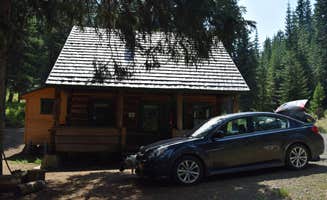Cabins near Clearwater National Forest provide rustic accommodations in Idaho's remote wilderness areas. Located predominantly between 4,000-6,000 feet elevation, these forest service properties experience temperature shifts ranging 30-40 degrees between day and night. Most cabins remain inaccessible during winter months due to heavy snowfall that blocks service roads from December through April.
What to do
River activities: The Lochsa River at Three Rivers Resort & Campground offers exceptional whitewater experiences during peak season. "The resort is located along a sweeping bend of the Lochsa river, which the highway follows on the opposite side," notes visitor Todd M., who adds that river raft guides frequently take out at this location.
Gold mining history: Visit Florence near Adams Ranger Station for historic gold mining sites. "Near by attractions are Florence which is a well known location for gold mining in days past, nice place to hike and explore the area's history," recommends Lesley R.
Digital detox: Use cabin stays for intentional disconnection from technology. Most properties lack cell service, creating opportunities for focused outdoor time. "There is no cell service here, so prepare for the trip ahead, print out your maps to the station, otherwise getting lost on your way here is a very likely possibility," cautions a visitor about planning requirements.
What campers like
Convenient overnight locations: Magruder Rangers House provides potable water access uncommon among forest cabins. This drinking water availability eliminates the need to transport gallons from distant towns, making it preferred for travelers moving between destinations.
Diverse accommodation options: Three Rivers Resort offers multiple lodging types beyond standard cabins. "The 'resort' has riverfront cabins, double occupancy motel rooms, A frame cabins, RV spots with hookups and a large tent camping area for motorcyclists, bicyclists and hikers," explains Todd M., highlighting how "the mix of campers makes things interesting."
Staff flexibility: Campground staff often accommodate reasonable requests for cabin visitors. "I waited around to see if it was filling up for the night and then asked how much it would be to pull into an RV spot to sleep in the car. She let me switch free of charge! She was amazing," reports Dani R. about her experience at Three Rivers Resort.
What you should know
Reservation requirements: All forest service cabins require advance bookings through recreation.gov, typically available 6 months ahead. Walker Cabin and others fill quickly during summer months. Cancellations incur fees unless made more than 14 days before arrival.
Supply preparation: Most cabins require comprehensive packing. "BYO drinking water, headlamps and sense of adventure. Pack out what you pack in," advises a visitor about Adams Ranger Station.
Limited amenities: Understand specific features before booking. Johnson Creek Guard Station offers 30-amp electrical hookups but no water connections. Burgdorf Guard Station includes water hookups but no toilets, requiring visitors to bring portable solutions.
Connectivity options: Internet access varies by location. "There was no cell service for AT&T, but the market and bar had WiFi that you could access by sitting outside the front door," notes Todd M. about Three Rivers Resort facilities.
Tips for camping with families
Off-grid preparation: Create detailed packing lists for cabin stays with children. Include entertainment options that don't require electricity, extra batteries for lights, and more water than you estimate needing. Most forest cabins lack power outlets for charging devices.
Restaurant access: Lost Horse Guard Station has no nearby food options, requiring all meals be packed in. Alternatively, Three Rivers Resort includes food service. "The hamburgers at the restaurant were perfect for our tastebuds after a long day on the road," reports Steven L. about the convenience of onsite dining.
Pet policies: Verify animal restrictions before booking. Horse Heaven Cabin and Three Rivers Resort allow pets, while Adams Ranger Station prohibits animals. Each property lists specific pet policies on reservation pages, including restrictions on number and size.
Tips from RVers
Hookup limitations: Burgdorf Guard Station provides electric and sewer connections but lacks standard RV amenities. No dump stations exist onsite, requiring advance planning for black water management.
Road conditions: Access roads to forest service cabins frequently contain unpaved sections requiring high-clearance vehicles. During spring, mud can make final approaches impassable even for 4WD vehicles. Visitors should contact ranger districts for current road status before departure.
Supplemental camping: Three Rivers Resort accommodates overflow needs with flexible options. "We needed an RV spot for the night on our way to McCall Idaho. Booking was straightforward, checking easy and was as described," explains Steven L. "Lack of black water capability was not an issue in our case and if needed there was a dump station on site."


